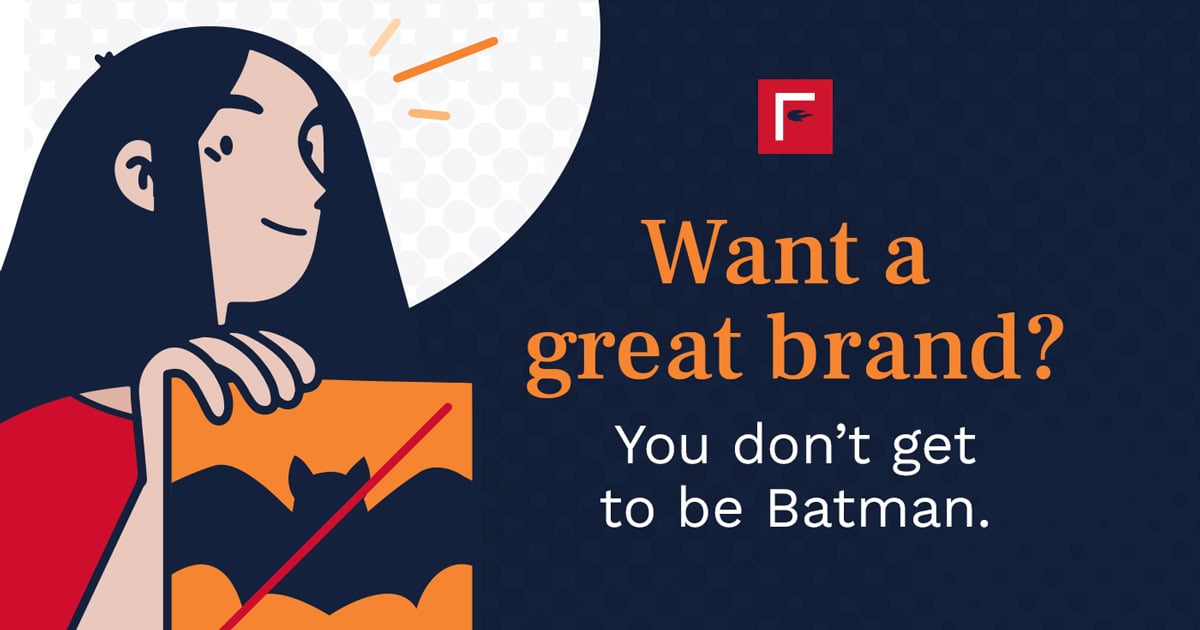I get it, we all want to be Batman. (According to various sources of internet lore, up to 97 percent of men think they are Batman.)
But if you want a smart brand for your law firm, it may be time to hang up your cape.
Background
This fall, I’ve been collaborating with Jesse Wroblewski of Decommoditized for a series of presentations on how law firms can differentiate themselves.
At each conference, we ask the audience to think of the ideal spokesperson for their firm. There are no constraints: The person can be long dead, the person could be fictional, the person could be prohibitively expensive.
We’ve gotten some great answers, ranging from Andy Griffith to Queen Elizabeth II, but perhaps the most important takeaway for me has been what I now call the Batman Principle of Branding.
Jesse had worked with a law firm that, in the same exercise, chose Batman. Again, who wouldn’t want to be Batman? The look, the voice, the toys, I get it.
The problem: The firm wasn’t Batman. The firm was Alfred.
The Batman Principle of Branding
Put coolness aside. What would make Batman a good personification of a law firm? He’s unreliable. He keeps weird hours. He has a host of relentless enemies. Half of Gotham jurors think he’s a villain.
Meanwhile, there’s Alfred: Calm, smart, reliable. Alfred keeps secrets, maintains order, makes sure you’re in the right place at the right time.
Most of all, Alfred isn’t trying to be the hero: Alfred empowers Batman to be the hero.
This brings us to the Batman Principle of Branding: Your clients don’t want you to be Batman. They want you to help them be Batman.
If you serve corporate clients, you are working with in-house counsel; these are smart and talented lawyers whose positions (and compensation) rely on them being the hero to the C-suite.
If you serve consumers, many are in precarious life situations: facing criminal charges, experiencing domestic upheaval, recovering from a serious injury. Psychologically, they need and want to take charge of their own lives.
Consider the formula popularized by StoryBrand: A character (your client) has a problem and meets a guide (that’s you) who gives them a plan.
The Argument for Alfred
Notably, StoryBrand advises: “What people really care about is their own story. When your brand stops playing hero and starts playing the role of guide in your customer’s story, you’ll see dramatic results.”
Let’s go back to the personification exercise. The specific goal of this work is to develop a character who can represent your firm. It’s a hypothetical exercise: You will likely not use this individual in advertisements or Instagram posts, but by personifying your firm, you can ensure that your brand voice – how you write and present – is clear, consistent and effective at connecting with your target audience.
To demonstrate the difference between a Batman and an Alfred, try out some of your firm verbiage on ChatGPT.
Let’s look at some familiar language: “Past results do not guarantee future results. Every case is different and should be evaluated on its own merits.”
From Batman: “Victory isn’t a promise — it’s a battle fought in the shadows, one case at a time. Every fight is different. And nothing is ever guaranteed.”
From Alfred: “While past successes are commendable, they’re no guarantee of future outcomes. Each case is unique and deserves its own careful attention. But with the right approach, there’s always hope.”
You can see the difference — but you can also feel the difference.
The Alfred voice is more professional and reassuring, and it turns out that this can have compelling benefits for your firm beyond slick communications. While firm positioning can vary widely, most human beings respond better to a tone that’s reassuring and professional. Indeed, according to research we’ve discussed previously, 82 percent of client sentiment is driven by two factors: warmth and competence.
The interplay of warmth and competence results in an emotional response of “admiration,” leading to attraction, affiliation and alliance — and long-term benefits of repeat business and referrals. Meanwhile, Batman’s cold competence results in mere “obligatory association.” Even the clients who seek out a “bulldog” for the courtroom won’t stick around for additional matters or Avvo reviews.
Alfred in Action
When lawyers adopt the Alfred position — a smart, sharp resource ready to help the client vanquish the villain — they can deliver the kind of selfless service that gets remembered.
Years ago, I worked with a lawyer who helped secure a massive recovery from a corporate client’s insurer. The money was set to come in at the end of December. Instead of having the insurer wire it, this lawyer had the insurer cut a check — and then he flew the check to the corporate headquarters.
He then gave the check to the in-house lawyer, so she could deliver it to the CFO. She got to deliver a multimillion-dollar check that boosted the company’s fourth quarter. She got to be the hero.
As Commissioner Gordon might say, that’s the lawyer that Gotham deserves.
Holy Brand Voice, Batman!
The personification exercise is such a fun, powerful way to determine how your firm will present itself to your potential clients.
Get creative, but heed the Batman Principle of Branding: Is your ideal spokesperson stealing the glory from your client?
If your first answer is a hero figure, a powerful protagonist or a main character, think: Who’s the person behind this person?
Maybe you’re not Jed Bartlett; maybe you’re Josh Lyman.
Maybe you’re not Taylor Swift; maybe you’re Tree Paine.
Maybe you’re not Michael Jordan; maybe you’re Scottie Pippen.
Let the client take the spotlight, and you’ll have far more Bat signals to answer.

